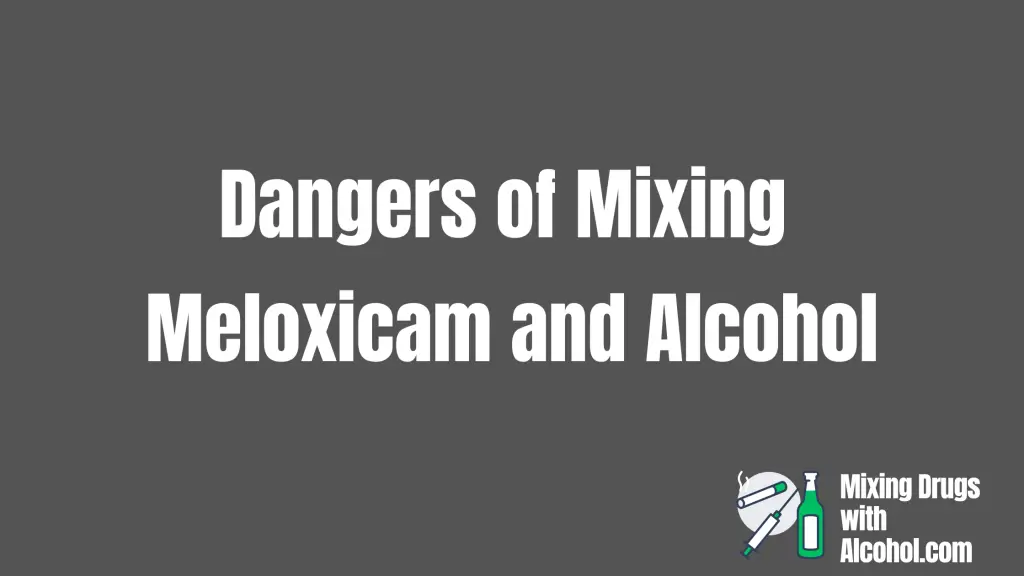Combining alcohol and drugs can be dangerous, and it’s important to understand the risks before mixing substances. Meloxicam is a nonsteroidal anti-inflammatory drug commonly used to manage chronic pain and inflammation.
However, taking meloxicam with alcohol can lead to changes in hormone levels and increase the risk of side effects. It’s crucial to be informed about these effects to make informed healthcare choices. This article explores the risks associated with mixing meloxicam and alcohol.
How Long After Taking Meloxicam Can You Drink?
Mixing meloxicam and alcohol can be dangerous due to the increased risk of stomach irritation and liver strain. Meloxicam belongs to the class of nonsteroidal anti-inflammatory drugs that reduce inflammation and pain.
Experts recommend waiting at least 24 hours after taking the last dose before consuming alcohol. Consult with a healthcare provider before consuming any form of alcohol while taking meloxicam or other NSAIDs due to individual health differences.
What Is Meloxicam?
Meloxicam is a COX-2 inhibitor NSAID used for pain and inflammation. It’s available in tablet or oral suspension form, with common side effects including upset stomach, heartburn, headache, dizziness, drowsiness, constipation, nausea, and rash.
If you’re taking meloxicam, it’s important to consult your doctor or pharmacist before drinking alcohol, as drinking while taking any medication can have potential risks or interactions. Your healthcare provider can give personalized advice based on your specific situation.
Is It Safe To Take Meloxicam With Alcohol?
Meloxicam is a prescription NSAID used for pain and inflammation caused by conditions like arthritis. Mixing it with alcohol is not recommended due to potential risks, including stomach bleeding and liver damage. This can also increase side effects such as dizziness and rapid heartbeat, and decrease the effectiveness of either substance.
It is best to avoid alcohol while using meloxicam to ensure safety. Consulting a healthcare provider can help determine the best course of action based on medical history and lifestyle changes that may reduce symptoms without relying on medications with harmful interactions.
Side-Effects Of Taking Meloxicam And Alcohol
Meloxicam is a nonsteroidal anti-inflammatory drug (NSAID) used to relieve pain, swelling, and stiffness caused by conditions such as osteoarthritis and rheumatoid arthritis. Alcohol is a depressant that affects the central nervous system. Combining meloxicam and alcohol can increase the risk of side effects and complications. Below are some short and long-term side-effects of taking meloxicam and alcohol together:
Short-term side effects:
- Dizziness: Taking meloxicam and alcohol together can cause dizziness, lightheadedness, and difficulty in concentration.
- Stomach upset: Both meloxicam and alcohol can irritate the stomach lining, leading to nausea, vomiting, and abdominal pain.
- Increased risk of bleeding: Meloxicam can increase the risk of bleeding, and alcohol can further increase the risk, leading to excessive bleeding from cuts or bruises.
- Kidney damage: Combining meloxicam and alcohol can damage the kidneys, leading to decreased urine output, swelling, and fatigue.
Long-term side effects:
- Increased risk of gastrointestinal bleeding: Prolonged use of meloxicam and alcohol can cause gastrointestinal bleeding, leading to severe stomach pain, black stools, and vomiting blood.
- Liver damage: Both meloxicam and alcohol can damage the liver, leading to jaundice, abdominal pain, and fatigue.
- Cardiovascular problems: Long-term use of meloxicam and alcohol can increase the risk of heart attack, stroke, and high blood pressure.
- Addiction: Alcohol is highly addictive, and combining it with meloxicam can increase the risk of developing alcohol dependence.
It is essential to consult with a healthcare provider before taking meloxicam and alcohol together, especially if you have a history of liver or kidney disease, high blood pressure, or bleeding disorders. The combination can be dangerous, and its risks should be carefully weighed against its potential benefits.
How To Take Medication Safely
To maintain a healthy lifestyle, it’s crucial to take medication safely. Patients should consult their doctor or pharmacist before starting any new treatment to understand the benefits and potential risks associated with the drug regimen. They should also ask about possible interactions with OTC medicines, supplements, and food items or beverages, including alcohol, as some medications can increase its effects, leading to serious health concerns.
Patients should follow the special instructions provided by healthcare professionals regarding when and how often to take each dose. Good communication between patients and healthcare providers is crucial to ensure successful outcomes for any medical plan involving medications.
Taking Meloxicam And Other Drugs
Taking meloxicam and other medications together can be dangerous and potentially life-threatening. Mixing prescription drugs with alcohol should also be avoided. To ensure safe intake, patients should speak with their healthcare provider before taking any new drugs or supplements alongside existing prescriptions.
While some individuals may require multiple medications, healthcare professionals will carefully consider all factors to minimize harm while providing relief from symptoms.
Meloxicam And Caffeine Interaction
Understanding the potential risks of combining caffeine and meloxicam is crucial due to the possibility of serious side effects. Caffeine, found in various beverages and pain relievers, can cause jitters, restlessness, and increased heart rate when consumed in high doses. Meloxicam, a nonsteroidal anti-inflammatory drug, blocks certain enzymes to relieve pain. The combination of meloxicam and caffeine may increase the risk of experiencing adverse effects such as dizziness, headaches, or nausea.
Additionally, the absorption of both medications may be reduced when taken together, leading to less effective relief of symptoms. Therefore, it is recommended that those taking meloxicam limit their consumption of caffeinated products and consult their healthcare provider before combining them.
What happens if you drink after taking a meloxicam?
Drinking alcohol after taking meloxicam, a nonsteroidal anti-inflammatory drug (NSAID), can increase the risk of stomach bleeding, gastrointestinal ulcers, and other complications. Alcohol can also worsen meloxicam’s potential side effects, such as drowsiness, dizziness, and stomach upset.
Can I have one glass of wine on meloxicam?
It is not recommended to consume alcohol while taking meloxicam, even in small amounts like a glass of wine. The combination can increase the risk of stomach bleeding and other gastrointestinal issues. Additionally, alcohol can intensify meloxicam’s side effects, such as drowsiness and dizziness.
What should you not mix with meloxicam?
Meloxicam should not be mixed with other NSAIDs or blood thinners, as it can increase the risk of stomach bleeding and other complications. It is also not recommended to take meloxicam with alcohol, as this can worsen side effects and increase the risk of gastrointestinal problems. Additionally, those with certain medical conditions or taking specific medications should avoid or use caution when taking meloxicam.
Does meloxicam hurt the liver?
Meloxicam can cause liver damage, although it is rare. Those with pre-existing liver disease, heavy alcohol use, or taking other medications that affect the liver should use caution when taking meloxicam. Symptoms of liver damage can include abdominal pain, dark urine, and yellowing of the skin or eyes.
Is meloxicam toxic to kidneys?
Meloxicam can cause kidney damage or worsen pre-existing kidney disease. Those with impaired kidney function, a history of kidney disease, or taking medications that affect the kidneys should use caution when taking meloxicam. Symptoms of kidney damage can include swelling in the feet or ankles, decreased urine output, and fatigue.
- Drugs.com. (2021). Meloxicam and Alcohol/Food Interactions. Retrieved March 8, 2023, from https://www.drugs.com/food-interactions/meloxicam.html
- National Institute on Alcohol Abuse and Alcoholism. (2014). Harmful Interactions: Mixing Alcohol with Medicines. Retrieved March 8, 2023, from https://www.niaaa.nih.gov/publications/brochures-and-fact-sheets/harmful-interactions-mixing-alcohol-with-medicines
- Mayo Clinic. (2022). Meloxicam (Oral Route) Precautions. Retrieved March 8, 2023, from https://www.mayoclinic.org/drugs-supplements/meloxicam-oral-route/precautions/drg-2006713
- US National Library of Medicine. (2022). Meloxicam. Retrieved March 8, 2023, from https://medlineplus.gov/druginfo/meds/a601242.html
- National Center for Biotechnology Information. (2021). Meloxicam. Retrieved March 8, 2023, from https://pubchem.ncbi.nlm.nih.gov/compound/Meloxicam
- The World Health Organization. (2017). Alcohol and Health. Retrieved March 8, 2023, from https://www.who.int/news-room/fact-sheets/detail/alcohol-and-health
- US Food and Drug Administration. (2022). NSAIDs – Nonsteroidal Anti-inflammatory Drugs. Retrieved March 8, 2023, from https://www.fda.gov/drugs/information-drug-class/nsaids-nonsteroidal-anti-inflammatory-drugs
- American College of Rheumatology. (2021). Meloxicam. Retrieved March 8, 2023, from https://www.rheumatology.org/Portals/0/Files/Meloxicam.pdf
- Medscape. (2022). Meloxicam (Rx). Retrieved March 8, 2023, from https://reference.medscape.com/drug/mobic-vivlodex-meloxicam-342205
- The National Health Service (NHS). (2022). Meloxicam. Retrieved March 8, 2023, from https://www.nhs.uk/medicines/meloxicam/
Similar Articles
Prednisone And Alcohol
Amoxicillin and Alcohol
Lexapro and Alcohol
Doxycycline Hyclate and Alcohol
Antidepressants and Alcohol
Muscle Relaxers and Alcohol
Nitrofurantoin and Alcohol
Blood Thinners and Alcohol
Pfizer vaccine and Alcohol
Valacyclovir and Alcohol
Indomethacin and Alcohol
Ashwagandha and Alcohol
Mirtazapine and Alcohol
Wellbutrin and Alcohol
Sertraline and Alcohol
Amlodipine and Alcohol
lisinopril and Alcohol
Duloxetine and Alcohol
Lorazepam and Alcohol
Oxycodone and Alcohol
Baclofen and Alcohol
Suboxone and Alcohol
Losartan and Alcohol
Metformin and Alcohol
Cefdinir and Alcohol
Nyquil and Alcohol

